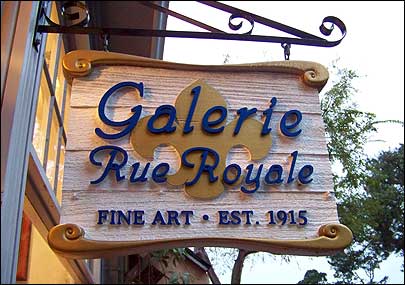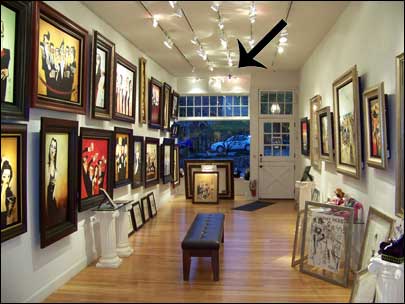Reeling from the blow dealt by Hurricane Katrina, and the subsequent slump in tourism, Jack Sutton found that running The French Art Network, a collection of family-owned fine-art stores located throughout The Big Easy, had become anything but easy.
Sutton and his partner considered opening new locations outside of New Orleans, but they were unsure how to keep tabs on employees managing high-value artwork in another city. They then heard about radio frequency identification, which opened up new landscapes for them. “We found a location in Carmel, Calif.,” Sutton says, “but we were scared about shipping art—which sells for anywhere from $2,000 to $20,000 each—2,000 miles away, and having a stranger running the store.”

The situation changed in March 2007, when Sutton began discussing his dilemma with an acquaintance, Ted Kostis, president of RFID systems developer and integrator Silent Partner Technology. Kostis suggested Sutton open remote locations and employ RFID to gain improved visibility of and control over his stock at all of his retail locations.
An RFID system, Kostis claimed, would allow Sutton and his staff to run automated (and more frequent) inventory counts, in order to get a handle on the whereabouts of the 75 to 150 pieces of art at each retail location (there are currently four such sites in New Orleans). “We used to take inventory once a month—though, in reality, it was more like each quarter or semi-annually,” Sutton says. “And there was a high error rate between what the database said was in each store and what was actually there.”

Within six months, Kostis and his staff developed a system for The French Art Network that uses active RFID tags and interrogators to perform automated inventory, while also helping to protect the items from thieves. The system has been deployed at the four New Orleans retail locations, as well as at a new store in Carmel. Kostis says the company also plans to deploy the system at three new locations—one more in Carmel and two in Santa Fe, New Mexico, by August. “This [RFID] system has given me confidence to go ahead with more locations,” Sutton says, “because I have more control now.”
As each new piece of art is received at The French Art Network’s main warehouse and distribution center, located in New Orleans, an employee inputs the name of the artwork—as well as other details, such as the artist’s name, a description of the piece, the cost and the sale price—into a database developed for the application by Silent Partner Technology. The worker then takes an RFID tag, made by Wavetrend and distributed by AAID Security Solutions, and reads its pre-encoded number, thereby associating the tag ID with the artwork’s database entry. That person then attaches the tag to the artwork with a Velcro strip.
The inventory database is Web-based, and is refreshed every ten minutes so that an up-to-date inventory list is made available to each store’s staff six times per hour. Once a piece of art is tagged and entered into inventory, it is shipped to a particular store—or store managers can put in requests to have the art shipped to their store.
The active tag operates at 433 MHz and employs a proprietary air interface protocol. A network of readers is installed within each store, enabling each tag within that store to be read, regardless of its location. The tag also provides a feature that fulfills one of Sutton’s main objectives: making the tag tamper-evident. “If someone can just peel off the tag and leave it in the store, the [RFID] system does me no good,” Sutton says. “So Ted [Kostis] spent a good amount of time working on that requirement and has made the system pretty bullet-proof.”
The Wavetrend tag includes a magnetic switch that is engaged by a magnet embedded in the Velcro strip used to mount the tag on the artwork. When a tag is mounted, the switch is triggered, and as the tag is later removed, the switch opens and that event is logged in the tag’s memory. Each piece of art is also assigned a bar code, associated with the tag number in the back-end database.
When a piece of art is purchased, an employee scans the bar code and removes the RFID tag. The software then associates the tag’s removal with the sale of the artwork to which it was attached. If the tag is removed but the bar code is not read, this triggers an alert in the software, which is transmitted to the store manager via e-mail. The manager can then search for the art, based on its last known location within the store, and investigate whether the tag has been removed without the piece being sold.
What’s more, because the tag keeps a running tab of the number of times its magnetic switch is engaged, the software can also deduce when a tag is removed from one piece of art and attached to another—presumably a lower-cost item—in an attempt to purchase the item at the lower cost.
In addition, the software tracks the locations of tagged art pieces as they move from one retail location to another, based on each piece’s tag being read by an interrogator mounted above the store’s back-room exit door, and later read by a reader mounted above the door at another location. Art is often moved between the New Orleans stores throughout a normal business day as customers make requests to view particular pieces.
According to Sutton, the software is configured so that he receives an e-mail every time a piece sells, or if a tag is removed without a related sale. He says he has not pinpointed any unethical behavior, based on the tag reads, to any particular stores. “The employees understand the system and know how it works,” he states, “and I don’t think they want to test me. They know they’ll get caught.”
Still, Sutton says, if the system prevents even one or two paintings from being stolen or sold at a lower price, that could provide a return on investment in just one year.


